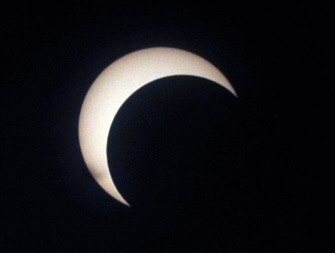An annular eclipse raced across central and eastern Africa Friday, briefly reducing the Sun to a blazing ring surrounding a sombre disk.

The solar coverup, visible in a roughly 300-kilometre (185-mile) band running 12,900 kms (8,062 miles), will at one point set a duration record that will remain unbeaten for more than a thousand years.
In the Ugandan capital Kampala motorcycle taxi drivers stopped on street corners to share dark glasses and gaze up at the sky.
Some residents were afraid of the intensity of the light.
"Can't it burn someone? You can't even look direct because I'm fearing for my eyes. I'm fearing it can burn me," said Angela Namukwaya, a shopkeeper in a Kampala suburb.
In Kenya, John Saitega, a 34-year-old Maasai and father of six in Olte Tefi 50 kilometres (30 miles) south of Nairobi, said he and his friends learned of the eclipse and the risk gazing at it carries for their eyesight from local radio and television.
They were all sharing one pair of dark goggles and taking turns to look at the Sun, he said.
"It's getting interesting. Birds are singing. It's actually getting cold here. It looks like night now," he told AFP.
An annular eclipse occurs when the Moon passes directly in front of the Sun but does not completely obscure it, thus leaving a ring -- an annulus -- of sunlight flaring around the lunar disk.
The Moon's shadow first struck the southwestern tip of Chad and western Central African Republic at 0514 GMT and then flitted across Uganda, Kenya, and Somalia.
The lunar umbra, or shadow was set to cross the Indian Ocean, Bangladesh, India, Myanmar and China before expiring in the Shandong peninsula at 0859 GMT.
























